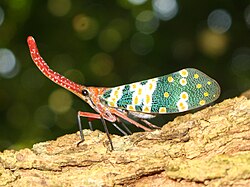| Pyrops | |
|---|---|
 | |
| Pyrops candelaria | |
| Scientific classification | |
| Kingdom: | Animalia |
| Phylum: | Arthropoda |
| Class: | Insecta |
| Order: | Hemiptera |
| Suborder: | Auchenorrhyncha |
| Infraorder: | Fulgoromorpha |
| Superfamily: | Fulgoroidea |
| Family: | Fulgoridae |
| Subfamily: | Aphaeninae |
| Tribe: | Pyropsini |
| Genus: | Pyrops Spinola, 1839 |
| Type species | |
| Pyrops candelaria (Linnaeus, 1758) | |
| Synonyms | |
| |
Pyrops is a genus of planthoppers that occur primarily in southeast Asia, containing about 70 species. [1] They are fairly large insects, with much of the length due to an elongated, upcurving, snout-like projection of the head. The wings are generally brightly patterned in contrasting colors, and they are popular among collectors.

